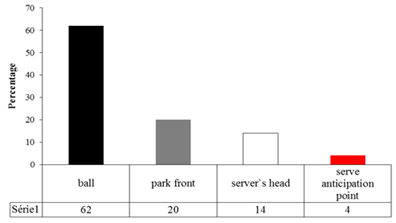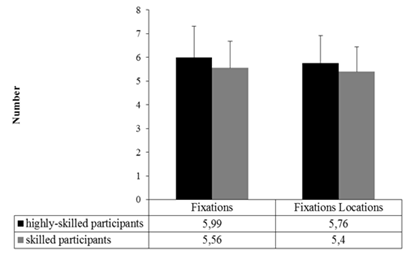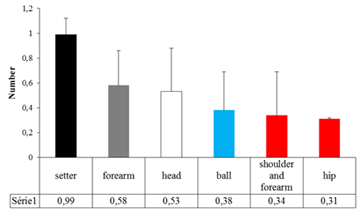MOJ
eISSN: 2574-9935


Mini Review Volume 2 Issue 5
Department of Science of the Human Motricity, Brazi
Correspondence: Nelson Kautzner Marques Junior, Department of Science of the Human Motricity, Brazil
Received: November 02, 2018 | Published: November 26, 2018
Citation: Junior NKM. Studies about the vision of the volleyball player during the skills. MOJ Sports Med. 2018;2(5):150-142. DOI: 10.15406/mojsm.2018.02.00063
The volleyball is a sport with the rally of few seconds and the pause has a duration of twice or more than the rally. The volleyball player during the rally practice skills (serve, reception, set, attack, block, and defense) and the vision with quality is important during the actions of these skills. What the vision action during the practice of the volleyball skills? The objective of the review was to present the results on vision during the practice of the volleyball skills. Lenoir et al.,1 determined the reception performance in relation to the type of color ball. The best reception was with the red-blue-white ball. Then Lenoir et al.,1 informed that color ball is important for the volleyball player because the color ball has an effect in the perception of the player for detecting the ball speed. McPherson and Vickers1 determined the vision action of the volleyball player during the reception of the overhand float serve. The volleyball players practiced highest percent of gaze were directed to the ball (62%). The gaze behavior is important for the volleyball player because causes a serve anticipation of the player. Afonso et al.,2 determined eye-movement during the defense in the backcourt. Highly-skilled participants practiced more number of fixations (p≤0.03) and of number of fixations locations (p≤0.04) than the skilled participants during the defense in the backcourt. Perhaps this is one of the reasons for more success of the defense of the highly-skilled participants. Maldonado et al.,3 determined vision behavior of the block player during the actions of the setter. The block player practiced more fixations for the moment that the setter runs to the ball and starts the set with a value of 0.99±0.13. The visual behavior of the block player is important for the coach knows the places that the athlete sees more for a guide during the block training. In conclusion, more vision studies during the volleyball match are needed to evolution this type of research.
Keywords: volleyball, vision, color vision, athletic performance, volleyball skills
Sports vision literature is important for the coach understands the action of the vision during the practice of the skills at the moment of the competition.4,5 The quality of the vision of the athlete is important for the sport because a better vision provides excellent skills during the match.6 The collective sports the players practice different skills and the vision is fundamental in the execution of the actions.7 Then, the researchers began to study of the vision during the practice of the sports skill8,9 and of others activities during the sport.10 The volleyball is a sport with a rally of few seconds and the pause has a duration of twice or more than the rally.11 The volleyball player during the rally practice skills (serve, reception, set, attack, block, and defense)12 and the vision with quality is important during the actions these skills.13
What the vision action during the practice of the volleyball skills?
The volleyball literature has most studies were elaborated during a laboratory condition14,15 and Afonso et al.,14 determined that the number of fixation during the volleyball match was of 5.35±0.91 and during the film was of 5.15±1.38. Therefore, the visual response during laboratory was different from the volleyball match. However, a review about the vision of the volleyball player during the practice of the skills during the match the volleyball literature did not write.15–17 The author of the article selected the studies on the volleyball during the practice of the skill (serve, reception, set, attack, block, and defense) at the moment of the match or of the game situation. The studies were collected with keywords volleyball and vision and volleyball vision in the database Google Scholar and Research Gate. The period of the research was of any year, but the study had to determine the visual behavior with high technology, for example with the VIA System, the Mobile Eye ASL, and others. Then, the objective of the review was to present the results on vision during the practice of the volleyball skills.
Vision behavior of the volleyball player during the skills
The vision of the volleyball player has a behavior according to the situation of the match.18,19 Therefore, the volleyball has a vision response of according to the type of skill practiced during the game.20 For example, Lenoir et al.,20 determined the reception performance in relation to the type of color ball. The best reception was with the red-blue-white ball, in second place stayed the blue-yellow-white ball, in third place stayed the green-red-white ball and in last stayed the green-red-white ball. However, the study of Lenoir et al.,1 had a limitation, the researchers did not determine the vision behavior. But the study of Lenoir et al.,1 is important for the volleyball because they determined the best reception in relation to the color ball. McPherson and Vickers7,8 recruited five male volleyball players of Canada. The study had the objective to determine the vision action of the volleyball player during the reception of the overhand float serve. The vision behavior of the volleyball player was determined with the VIA System of Vickers.21 The volleyball players practiced the highest percent of gaze (gaze is an indicator of visual attention) were directed to the ball (62%), Figure 1 illustrates the results.

Figure 1 Percentage of gaze behavior of the volleyball player during the reception (illustration elaborated by the author).
Then¸ others studies about the volleyball ball color are important because the volleyball player during the reception use more the vision by watching the ball. In conclusion, the study about gaze behavior is important for the coach understands the vision of the volleyball player during the reception. However, some volleyball coaches use the curtain training to exercise the player during the reception. Then, the researcher deserves to practice a curtain training study with the objective of determining the vision action. Figure 2 illustrates this type of training. Afonso et al.,2 recruited a total of 27 female volleyball players. The study had the objective to determine eye-movement during the defense in the backcourt. The participants were divided into two groups with highly-skilled participants (n=15, 19.1±8.3 years and with 9.2±6.5 years of volleyball) and skilled participants (n=12, 17.3±4.2 years and with 5.8±2.3 years of volleyball). The eye-movement behavior of the volleyball players was determined with the Mobile Eye ASL Lab during the defense actions in the backcourt. The data collection occurred in a volleyball game of six successful of the players. Therefore, at each point of the player was practiced a success. Highly-skilled participants practiced more number of fixations (p≤0.03) and of number of fixations locations (p≤0.04) than the skilled participants. The fixations locations were defined of ten locations during the match with the ball trajectory, action of the player and others. The fixation duration in milliseconds (ms) had no statistical difference (p=0.23) between the highly-skilled participants (596.29±165.70 ms) versus the skilled participants (627.15±163.01 ms). Figure 3 illustrates the result with difference statistical.

Figure 2 The volleyball player of the central zone use curtain during the reception. But of the left and right zone the players train without a curtain.

Figure 3 Eye-movements during the defense of the volleyball player (illustration elaborated by the author).
In conclusion, highly-skilled participants were more exploratory than the skilled participants because practiced more number of fixations and of fixations locations. Perhaps this is one of the reasons for more success of the defense of the highly-skilled participants. Maldonado et al.,3 recruited a total of 29 female volleyball players of 23.10±3.74 years. The objective of the study was to determine vision behavior of the block player during the actions of the setter. The block player stayed in center frontcourt or zone 3 with the block position. The block player watched the actions of the setter during the set in a film that was projected on a big screen. The block player watched 36 actions of the set and the visual block response was collected with the Mobile Eye ASL Lab. The number total of fixation was of 3.61 with duration of 3.56 seconds. The block player practiced more fixations for the moment that the setter runs to the ball and starts the set (setter) and others result the Figure 4 illustrates.

Figure 4 Visual fixation number of the block player during the actions of the setter (illustration elaborated by the author).
In conclusion, the visual behavior of the block player is important for the coach knows the places that the athlete sees more for a guide during the block training. The same researcher group of the study of Maldonado et al.,3 practiced other two studies about this theme,21,22 the reader can consult the internet for had this articles. The vision behavior during the volleyball skill has little studies. The researcher can conduct studies about the vision behavior during the type of attack tempo that is of three categories (1st tempo, 2nd tempo, and 3rd tempo).23–28 Volleyball biomechanics determined differences of the spike of the volleyball versus the beach volleyball.29 The researcher needs to the researcher the vision during the spike of the volleyball and of the beach volleyball. The sports vision literature determined that the quiet eye training causes a performance increase of several skills.30 Therefore the quiet eye training needs of study during overhand serve and during the jump serve. In conclusion, studies about vision behavior need of others researchers during the reception, the defense and during the block. The serve, the attack and the set the scientists need to practice the first studies about the vision during these skills.
The study about the vision behavior during the volleyball skill is important for the coach understands the vision action. However, the study about the vision determined the best color ball (was the red-blue-white ball) and the gaze of the volleyball player (62% directed to the ball). Then, the researcher need to conduct more studies to determine the color ball that the volleyball player gets better reception and defense with the objective of determining the best color ball for the official competitions. The fixations and fixations locations determined more number of the highly-skilled participants than the skilled participants during the defense. Then, the use of the Mobile Eye ASL or of the VIA System is important for determining the level of the volleyball player, but in the next study needs to determine the relation between the visual behavior and the defensive performance. The block player practiced more visual fixation number for the setter, for setter's forearm and head and for the ball. Then, the next study about the block player is necessary to determine the relationship between visual behavior and the block performance. Therefore, the researcher of the volleyball vision needs to identify how the volleyball player`s vision performs on each skill during the match or the game situation. In conclusion, more vision studies during the volleyball match are needed to evolution this type of research.
The author thanks the MOJ Sports Medicine invitation to write an article.
Author declares that there is no conflicts of interest.

©2018 Junior. This is an open access article distributed under the terms of the, which permits unrestricted use, distribution, and build upon your work non-commercially.